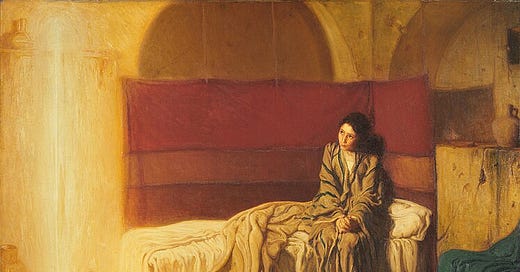Though Henry was beloved in France and was the talk of the town in Paris, he continued exhibiting his work in the U.S. In the late 1890s, he exhibited The Annunciation to the Pennsylvania Academy of the Fine Arts. The painting was a striking interpretation of the biblical moment when the angel Gabriel appears to Mary. Henry depicted Mary as a young peasant girl sitting humbly on her bed, bathed in a glowing light. It was a deeply human portrayal that captured the moment's awe and quiet gravity. Praise came in abundance and quickly. One paper, the Philadelphia Enquirer wrote,
"Mr. Tanner's paintings have always been markedly serious, honest, even exalted, but he has never shown in this country anything which in commanding quality approaches this beautiful work. ... The little figure [of the Virgin] is intensely human, and at the moment of painting the child-woman is divided between fear and exaltation. A beautiful picture it is—a sympathetic picture, a picture to be regarded, not critically — although it can bear criticism — but with appreciation. Americans may be proud that this country has produced a painter of Mr. Tanner's ilk. They are not numerous."
Stardom was in full swing for Henry now. Ironically, though, wealth didn't come with the fame. Henry himself reflected on this challenge:
"Making money never seemed my strong point, and yet I will not believe that I was stupid or that I had less ability than some who did make it. In painting, I know it came from never knowing what the popular taste was. Among my fellow painters, I have known some who always felt what should be done to please and did it more or less instinctively. Their 'pot boilers' always sold—mine usually remained on my hands and I was worse off than before—so that at the commencement at least of my career I deserve little credit for doing my level best, for nothing else received the slightest attention, but this meant long effort and extremely small pay, and so it has continued."
At about the same time, Henry's life underwent another profound change. He married Jessie Olsson, a Swedish-American woman he had met in France. Their interracial marriage, a relatively unremarkable event in Paris, posed challenges in America. The couple briefly considered moving to the U.S. and did spend time there, but ultimately decided to stay in Europe, especially after the birth of their only child in 1903.
For whatever worries the couple may have had, their marriage would prove to be loving, tender, and supportive. Shortly before passing away years later, Jessie would say to Henry, "I have never regretted one moment of our marriage."
Keep reading with a 7-day free trial
Subscribe to Historical Snapshots to keep reading this post and get 7 days of free access to the full post archives.




